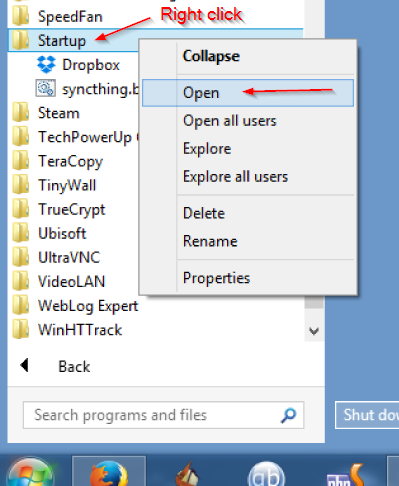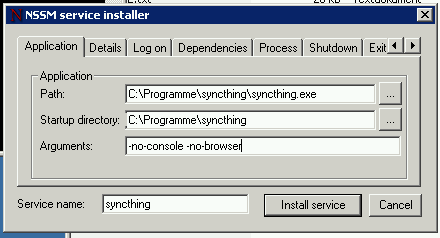Starting Syncthing Automatically¶
Warning
This page may be outdated and requires review.
Windows¶
There is currently no official installer available for Windows. However, there are a number of easy solutions.
Third-party Tools¶
There are a number of third-party utilities which aim to address this issue. These typically provide an installer, let Syncthing start automatically, and a more polished user experience (e.g. by behaving as a “proper” Windows application, rather than forcing you to start your browser to interact with Syncthing).
See also
Start on Login¶
Starting Syncthing on login, without a console window or browser opening on start, is relatively easy.
Find the correct link of the Windows binary from the Syncthing website (choose amd64 if you have a 64-bit version of Windows)
Extract the files in the folder (
syncthing-windows-*) in the zip to the folderC:\syncthingGo to the
C:\syncthingfolder, make a file namedsyncthing.batRight-click the file and choose Edit. The file should open in Notepad or your default text editor.
Paste the following command into the file and save the changes:
start "Syncthing" syncthing.exe -no-console -no-browserRight-click on
syncthing.batand press “Create Shortcut”Right-click the shortcut file
syncthing.bat - Shortcutand click CopyClick Start, click All Programs, then click Startup. Right-click on Startup then click Open.

Paste the shortcut (right-click in the folder and choose Paste, or press
CTRL+V)
Syncthing will now automatically start the next time Windows boots. No console or browser window will pop-up. Access the interface by browsing to http://localhost:8384/
If you prefer slower indexing but a more responsive system during scans, copy the following command instead of the command in step 5:
start "Syncthing" /low syncthing.exe -no-console -no-browser
Run independent of user login¶
Warning
There are important security considerations with this approach. If you do not secure Syncthing’s GUI (and REST API), then any process running with any permissions can read/write any file on your filesystem, by opening a connection with Syncthing.
Therefore, you must ensure that you set a GUI password, or run Syncthing as an unprivileged user.
With the above configuration, Syncthing only starts when a user logs in onto the machine. This is not optimal on servers, where a machine can run long times after a reboot without anyone logged in. In this case, it is best to create a service that runs as soon as Windows starts. This can be achieved using nssm.
Note that starting Syncthing on login is the preferred approach for almost any end-user scenario. The only scenario where running Syncthing as a service makes sense is for (mostly) headless servers, administered by a sysadmin who knows enough to understand the security implications.
Download and extract nssm to a folder where it can stay (e.g. c:Files or the Syncthing folder.
run nssm.exe install syncthing
Select
syncthing.exein the first tab and enter-no-console -no-browseras Arguments
at the Details tab you can switch to Automatic (Delayed Start) to start it only some time after boot and speed up the boot process (optional)
At the Log On tab you can enter a username and password for the user to run Syncthing as. This user needs to have access to all the synced folders. Usually, you can leave it as the System account.
At the Process Tab you can change the priority to low if you want a more responsive system at the cost of longer sync time
Click the Install Service Button
Start the service using the windows service manager, enter
sc start syncthingin a console window or restart the PC.Connect to the Syncthing UI, enable HTTPS, and set a secure username and password.
Mac OS X¶
Using homebrew¶
brew install syncthingFollow the info to autostart Syncthing using launchctl. At the moment this is done using this command:
launchctl load ~/Library/LaunchAgents/homebrew.mxcl.syncthing.plist.
Without homebrew¶
Download Syncthing for Mac: https://github.com/syncthing/syncthing/releases/latest.
Copy the syncthing binary (the file you would open to launch Syncthing) in a directory called
binin your home directory. If “bin” does not exist, create it.Edit the
syncthing.plist(located in /etc/macosx-launchd) in the two places that refer to your home directory; that is, replace /Users/jb with your actual home directory location.Copy the
syncthing.plistfile to~/Library/LaunchAgents. If you have trouble finding this location select the “Go” menu in Finder and choose “Go to folder…” and then type~/Library/LaunchAgents. Copying to ~/Library/LaunchAgents will require admin password in most cases.Log out and back in again. Or, if you do not want to log out, you can run this command in terminal:
launchctl load ~/Library/LaunchAgents/syncthing.plist
Note: You probably want to turn off “Start Browser” in the web GUI settings to avoid it opening a browser window on each login. Then, to access the GUI type 127.0.0.1:8384 (by default) into Safari.
Linux¶
Ubuntu like systems¶
Click the dashboard (hit ‘Win’ button).
Open ‘Startup Applications’.
Click ‘Add’.
Fill out the form:
Name: Syncthing
Command: /path/to/syncthing/binary -no-browser -home="/home/your\_user/.config/syncthing"
Supervisord¶
Add following to your /etc/supervisord.conf:
[program:syncthing]
command = /path/to/syncthing/binary -no-browser -home="/home/some_user/.config/syncthing"
directory = /home/some_user/
autorestart = True
user = some_user
environment = STNORESTART="1"
systemd¶
systemd is a suite of system management daemons, libraries, and utilities designed as a central management and configuration platform for the Linux computer operating system. It also offers users the ability to manage services under the user’s control with a per-user systemd instance, enabling users to start, stop, enable, and disable their own units. Service files for system are provided by Syncthing and can be found in etc/linux-systemd. Several distros (including arch linux) ship these service files with the Syncthing package. If your distro provides a systemd service file for Syncthing you can skip step 2.
How to use the system instance¶
Running Syncthing as a system service ensures that Syncthing is run at startup even if the Syncthing user has no active session. Since the system service keeps Syncthing running even without an active user session, it is intended to be used on a server.
Create the user who should run the service, or choose an existing one.
Copy the
system/syncthing@.servicefile into the load path of the system instance.Enable and start the service. Append the Syncthing user after the
@:systemctl enable syncthing@myuser.service systemctl start syncthing@myuser.service
How to use the user instance¶
Running Syncthing as a user service ensures that Syncthing is run after the Syncthing user has created a session (e.g. via the graphical login screen or ssh). Thus, the user service is intended to be used on a (multiuser) desktop computer. It avoids unnecessarily running Syncthing instances.
Create the user who should run the service, or choose an existing one.
Copy the
user/syncthing.servicefile into the load path of the user instance. To do this without root privileges you can use~/.config/systemd/user/.Enable and start the service:
systemctl --user enable syncthing.service systemctl --user start syncthing.service
To check if Syncthing runs properly you can use the status
subcommand:
systemctl status syncthing@myuser.service
systemctl --user status syncthing.service
Using the journal¶
Systemd logs everything into the journal. You can easily access Syncthing
log messages (-e lets the pager jump to the very end):
journalctl -e -u syncthing@myuser.service
journalctl -e --user-unit=syncthing.service
Debugging¶
If you are asked on the bugtracker to start Syncthing with specific environment variables it will not work the easy way. Systemd isolates each service and it cannot access global environment variables. The solution is to add this variables to the service file instead. Just use:
systemctl edit syncthing@myuser.service
systemctl --user edit syncthing.service
This will create an additional configuration file automatically and you
can define (or overwrite) further service parameters like e.g.
Environment=STTRACE=model.